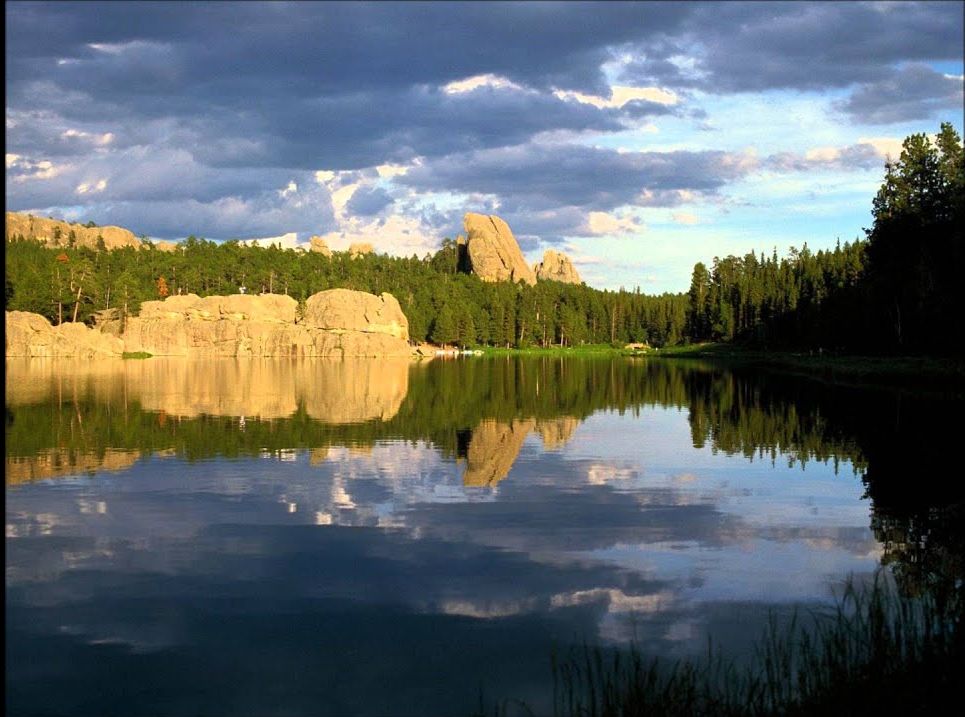Black Hills, South Dakota

The following article is from the blog, “The Geometry of Place” by Peter Champoux. Peter explains why the Black Hills are so sacred to the Lakota Tribe.
What follows is initial findings on the Black Hills cosmological landscape of the Lakota, Dakota, Nakota Peoples as requested by Chief Arvol Looking Horse, 19th Generation Keeper of the Sacred White Buffalo Calf Pipe.
In total, the Black Hills resemble a heart – from an eagle’s point of view. As the seasons change the coloration of the hills change giving the appearance (in time-lapse imagery) of a beating heart. Native Peoples refer to this unique geologic formation as ‘the heart of all that is’.
The heart of the Great American Plains, the Black Hills is ‘THE’ metal deposit on the continent. The massive conquest invasion of the west with iconographic miners is an indication of its rich mineralogical complexity. Gold, silver, uranium, copper, lead, lithium, bentonite clay, limestone, basalt, sandstone, and … all mix into this alchemical brew.
The ‘Heart of All that Is’ is an amalgam of the elements at the center of Lakota cosmology: Star Knowledge, and North America’s Great Plains. As a geologic phenomenon, the Black Hills is anomalous or different from the usual. In Algonquin terms, they have ‘manitou’. Essentially the Black Hills are a metallic granite batholith that grew toward the sun from the surrounding lime sandstone clay overburden. In so many words, a simple battery/ generator/ coil/ armature/ spark… the heart of all that is.
Throughout the North American Continent granite plugs, the core of extinct volcanos, are centric points for land geometries. Many of these granite outcroppings are considered sacred sites by native peoples. The Black Hills are one such sacred center. Granite is a piezoelectric rock. In other words, it carries an electrical charge. Rooted to the planet’s core the granite spires of the Black Hills reach from the depths of the earth to touch the sky, linking the seven dimensions. Another one of these granite plugs is located at the center of the Arkhom geometry in western Massachusetts. While the Arkhom geometry is more organized or static, the Black Hills exhibit a more vibrant, complex, and concentrated growth dynamic, with a preponderance of the phi (1:1.618…) proportion in its ceremonial landscape.
Lakota Star Map ( see the book –Lakota Star Knowledge by Ronald Goodman) identifies a Lakota system of living that followed ‘the good red road’. This ‘red road’ refers to a pathway that can be seen both in the pattern of the stars and a ring of red clay that encompasses the Black Hills. To the Lakota, the landscape is a mirror of celestial patterns
Mt Harney = the Seven Dancers (Pleiades)
Devil’s Tower/Bear Lodge Mts. = Castor and Pollux.
The Lakota Star Map, (R. Goodman) placed to overlay the sites associated with stars on the land is the green line and pent stars (see attached graphic). In this instance, the Lakota Star Map matched the paired spots in four instances. A crucial piece is that the ‘Raceway’ around the Black Hills does not match the celestial raceway when geopositioned over corresponding sacred sites. Nor is the center, Pe Sla (Reynolds Prairie) positioned at the center of the star overlay as described in Lakota Star Knowledge. These correspondent disconnects don’t worry me much as the symbolic and tangible sense of place qualities (discussed later in this article) more than makeup for these deviations.
Spiral of Sacred Sites
The phi spiral shape (illustrated on accompanying graphic) was sized to connect Lakota sacred sites. The primary Star Knowledge sites are Pe Sla, Mt. Harney, Bear Butte, and Rock Butte (Gray Buffalo Horn Butte) or Devil’s Tower. The Lakota speak of their circular ceremonial pathway around the Black Hills as being clockwise in direction. Visualizing this circular migrational ‘good red road’ as creating this phi spiral, one can understand the life-breath that the Lakota ceremonial cycle instills in the land as they lived and prayed and danced.
The phi proportion and the phi spiral is common geometry and proportion found in nature. The conch nautilus shell is a phi spiral as well, the proportions of the human body are based on this proportion that ‘IS’ nature, the God number.
Throughout the Lakota ceremonial cycle, this proportion is instilled in the land as ‘the people’ followed the constellations from Winter Camp to Pe Sla, to the center of the Black Hills, to Inyan Kara, to Stone Butte, completing the cycle at Bear Butte, the home of the Great Mystery.
Thus, it is the total of the year that generates and sustains phi – life. Phi beings (Lakota) traveling the ‘good red road’ (a phi spiral) would generate a vital connection to the creative resonate field of the Black Hills. A co-creation of life.
The Purification Lodge
As stated before, the Star Knowledge of the Lakota perceived this circle of stars as a mirror of the ‘good red road’ around the Black Hills. While not exactly matching this constellation pattern there are very solid connections with sites around the ‘heart of all that is’. Symbolizing the road of life, Star Knowledge identifies this amalgam of stars also as a representative of a purification lodge. While Lakota cosmology (as described in Goodmen’s book) has Pe Sla as the center of this land-based constellation, when overlaid point to point, the site geopositioned at the center of this star pattern is Inyan Kara.
This relationship is quite appropriate. Inyan Kara is a sacred Butte on the west side of the Black Hills. It is from here that the ‘grandfathers’ or central fire stones are gathered for the purification rites that precede the Sun Dance. Inyan Kara thus is corespondent to the fire pit’s position at the center of the lodge. While not specifically part of the Star Knowledge teachings, Inyan Kara, from this overlay, is the center of the land constellation not Pe Sla at the center of the Black Hills. Inyan Kara’s position also relates to the Crab Nebula, a star generating powerhouse, not unlike the glowing forms of the ‘grandfathers’ in the center of the purification lodge.
For more on this article please go to http://www.geometryofplace.com/bkhills.html









